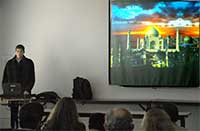International students share culture
By CINDY GONZALES
Every Tuesday afternoon, Fresno State students get a taste of international
presence around the campus thanks to the International Coffee Hour program.
The program aimed at helping Fresno State students understand international
cultures one cup of coffee at a time.

Hyder Alamgir said he wanted to give his audience a different
view of the Middle East.
Photo by Joseph Hollack |
International student electrical engineering major Hyder Alamgir said
he was presenting his culture to discuss the good things about his country
that are never reported in the media.
“I want them to understand the Middle East is not a place filled
with violence,” said Alamgir, a Pakistani citizen who grew up in
Kuwait.
Before spring break, the program brought together students to discuss
the naming systems and language backgrounds of the Japanese and Hmong
cultures.
“The coffee hour lets you feel and see how the other people are
feeling about you,” said Tom Eizadi, a sophomore majoring in computer
science.
“It’s important that we understand all of the different cultures,”
Eizadi said.
Miho Takagi and John Lor were the featured speakers March 15.
Takagi, a graduate student in education, discussed the naming system in
the three Japanese scripts: Kanji, Hiragana, and Katakana.
“If you make friends with a Japanese person, please try asking them
what their names mean,” Takagi said. “Their names may mean
something that will surprise you.”
Takagi said both of her names are in the Kanji script. Her last name,
Takagi, means “tall trees” and her first name, Miho, is Mi
meaning “beauty” and ho meaning “steps or walking”
which translates to “hoping to lead life beautifully.”
Kanji originally came from Chinese and each of the 2,232 characters conveys
a meaning all it’s own.
Hiragana is the written language that has no meaning in the characters
but is used because of its softer script and sound. Katakana is the script
most often used in official documents.
“Because [the Japanese] use all three scripts to write the language,
it might be confusing for foreigners to learn,” said Mayu Saito,
an international student from Japan majoring in enology.
Saito said when she has a child, she will give the child a Japanese name
that is easy to pronounce in English to help him or her be a better international
student.
Lor, a graduate student in counseling and student services discussed the
naming system in the Hmong culture.
The two dialects in Hmong are called the white and green, or blue, dialects.
Lor said both dialects are easy to comprehend because there is no vast
difference, except in the accents.
In the Hmong culture, your last name determines which one of the 18 Hmong
clans you belong to. Marrying within your clan is not permitted.
Lor said it’s very important for single Hmong people to ask what
the other person’s last name is to avoid falling in love with someone
from their clan.
“If you marry someone with your last name, it would be considered
incest. It is taboo,” Lor said.
Lor said as assimilation begins to take place, and the spellings of the
last names begin to change, the Hmong language will also change.
“But the Hmong language is tonal, like many Asian languages,”
Lor said. “If you’re not a native speaker, it may be hard
to distinguish the differences.”
|
